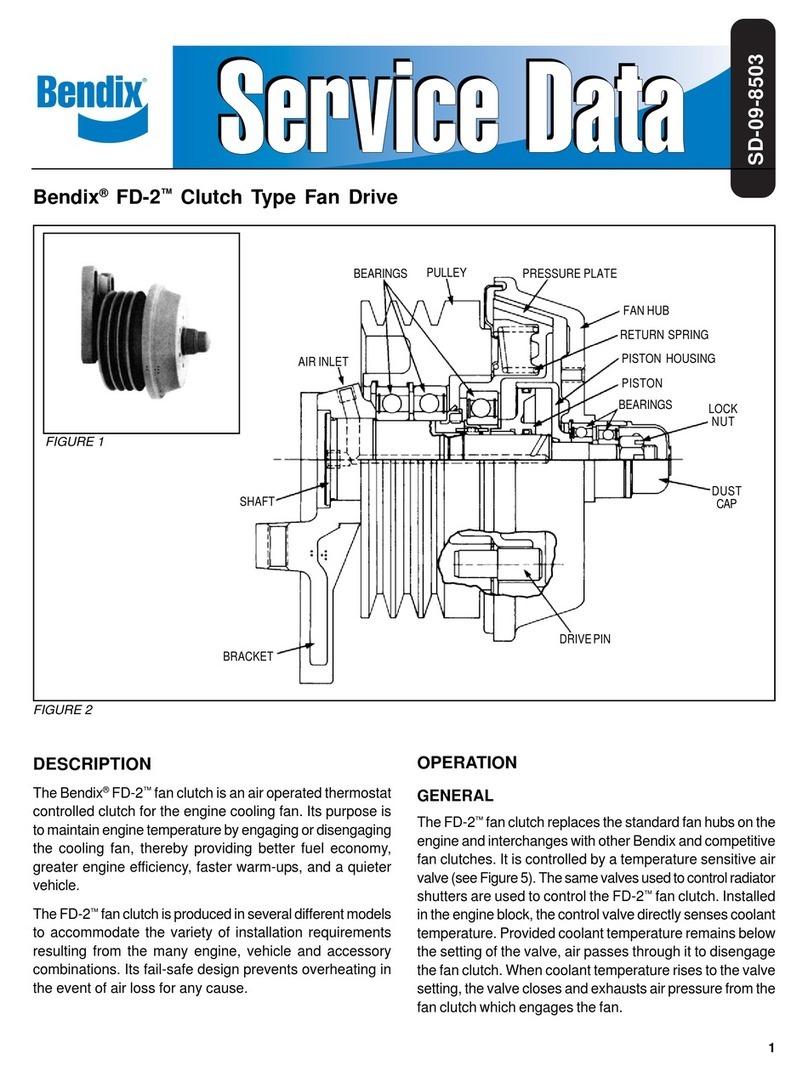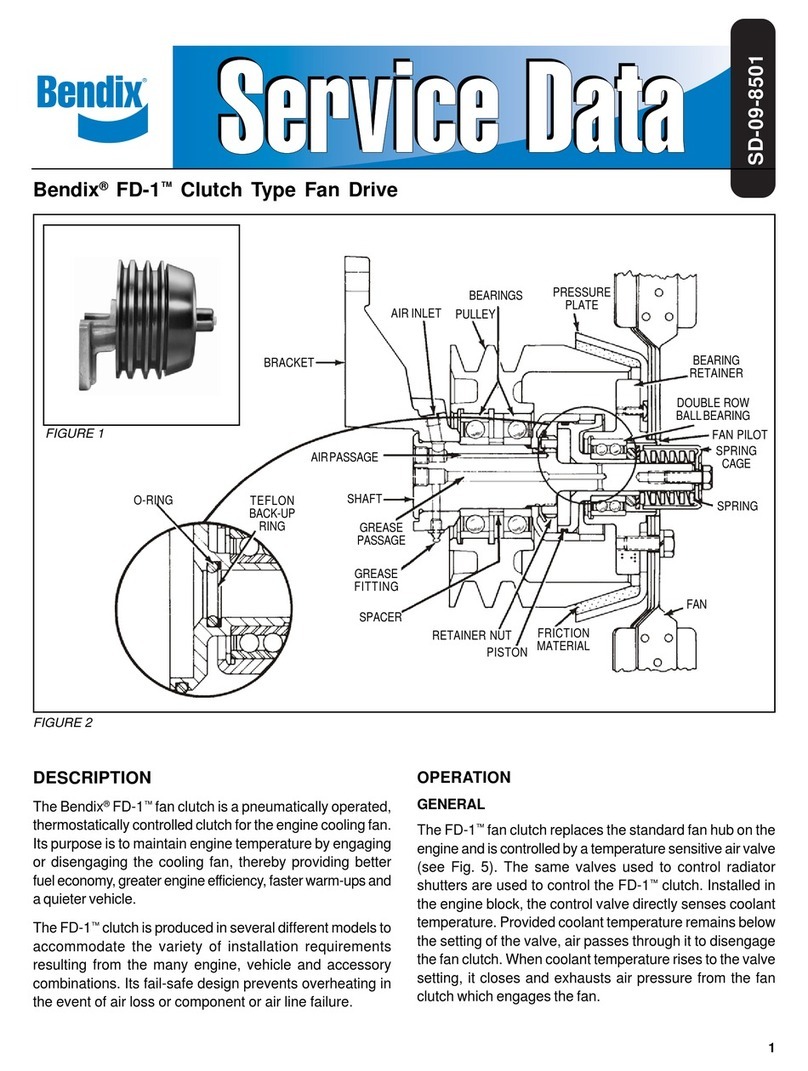
5
B. Ifthe fanclutch installation hassuccessfully passed
this test before, but does not do so now, the
thermostaticcontrolvalve isdefectiveandshould be
replaced.
4. With the clutch in the engaged position (control air
vented),checkthecondition ofthedrive pinsandmating
holes in the pressure plate by attempting to rotate the
fanclockwiseandcounterclockwise.If freeplayexceeds
5/16” (8 MM), fan clutch must be repaired or replaced.
LEAKAGE CHECKS
In order to check for air leakage past the only two sliding
o-ringsinthe FD-3™TorqueMasterfan clutchit isnecessary
to disconnect the single air control line.
Checkforleakagebyconnectinga90cu.in.reservoir(Bendix
part number 225000) with a gauge installed to the control
portof thefan clutch.Afterfilling the90 cu.in. reservoirwith
100 psi, allow the pressure to stabilized and observe the
time required for the reservoir pressure to drop to 90 psi. If
thetimerequired islessthan 1minute,leakage isexcessive
andrepair orreplacement is necessary.
WARNING! PLEASE READ AND FOLLOW
THESE INSTRUCTIONS TO AVOID
PERSONAL INJURYOR DEATH:
When working on or around a vehicle, the following
general precautions should be observed at all times.
1. Park the vehicle on a level surface, apply the
parking brakes, and always block the wheels.
Always wear safety glasses.
2. Stop the engine and remove ignition key when
working under or around the vehicle. When
working in the engine compartment, the engine
should be shut off and the ignition key should be
removed. Where circumstances require that the
enginebe in operation, EXTREMECAUTION should
be used to prevent personal injury resulting from
contact with moving, rotating, leaking, heated or
electrically charged components.
3. Do not attempt to install, remove, disassemble or
assemble a component until you have read and
thoroughly understand the recommended
procedures. Useonly the proper tools and observe
all precautions pertaining to use of those tools.
4. If the work is being performed on the vehicle’s air
brake system, or any auxiliary pressurized air
systems,makecertainto drain the air pressure from
all reservoirs before beginning ANY work on the
vehicle. If the vehicle is equipped with an AD-IS™
air dryer system or a dryer reservoir module, be
sure to drain the purge reservoir.
5. Following the vehicle manufacturer’s
recommendedprocedures, deactivate the electrical
system in a manner that safely removes all
electrical power from the vehicle.
6. Never exceed manufacturer’s recommended
pressures.
7. Never connect or disconnect a hose or line
containing pressure; it may whip. Never remove a
component or plug unless you are certain all
system pressure has been depleted.
8. Use only genuine Bendix®replacement parts,
components and kits. Replacement hardware,
tubing, hose, fittings, etc. must be of equivalent
size, type and strength as original equipment and
be designed specifically for such applications and
systems.
9. Components with stripped threads or damaged
parts should be replaced rather than repaired. Do
not attempt repairs requiring machining or welding
unless specifically stated and approved by the
vehicle and component manufacturer.
10. Prior to returning the vehicle to service, make
certain all components and systems are restored
to their proper operating condition.
REMOVAL
Itis recommended thatthe FD-3™TorqueMaster fanclutch
be removed from the vehicle for service even though it is
possible on some installations to install kits 104937 and
104938without clutchremoval.
1. Secure the vehicle on a level surface by means other
than the brakes.
2. DrainALLreservoirs to 0 psi (0 kPa) air pressure.
3. Disconnect the air line from the fan clutch.
4. Removethesix capscrewsand lockwashersthatattach
thevehicle’sfantothefanplateoftheFD-3™TorqueMaster.
5. Removethefan.NOTE: Removeandretainanyspacers
that may be installed between fan and fan plate
assembly.
6. Loosen,remove andretain the vehicle’sfan belts.
7. Remove the attaching hardware from the fan clutch
mounting bracket and remove the fan clutch from the
vehicle.
DISASSEMBLY (Refer to Figure 9)
1. Removethe dustcap(1) bypulling itoff ofthe endof the
shaft.
2. Removethe cotter pin(2)from the lock nut(10).
3. Removethe locknut(10).
4. Removethe fan plate assemblyand set aside.
5. Slidethe pistonhousing(15)and piston(16)offthe shaft.
6. Separatethepiston(16)from thepistonhousing(15)and
removethe o-rings(4 &5) from thepiston.
7. Removeo-ring(3)fromtheshaft.
8. Remove pressure plate(7) from the shaft. Remove the
four o-rings(6) from the drive pin holes in the pressure
plate.
9. Removethetwo1/4”x20Phillipsheadscrewsthatsecure
thespringpack(9)to thepulley.Removethespring pack.
10. Removetheanti-rotation spring(17).
11. Using a drift punch, disengage the locktab of the
lockwasher(23)from the notchof thelocknut(18).




























